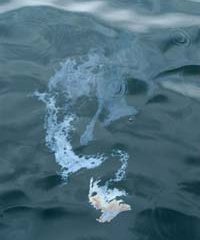Interdisciplinary Research
News and developments from the field of interdisciplinary research.
Among other topics, you can find stimulating reports and articles related to microsystems, emotions research, futures research and stratospheric research.

WHOI Scientists Respond to Buzzards Bay Oil Spill
Woods Hole Oceanographic Institution (WHOI) scientists from diverse disciplines have responded to the April 27 spill of nearly 15,000 gallons of No. 6 fuel oil into Buzzards Bay, drawing on decades of experience studying the effects of oil spills on the marine and coastal environment.
Marine chemists have collected dozens of oil samples spilled into Buzzards Bay by the barge Bouchard 120 to determine the chemical composition of the petroleum spilled and its potential toxicity. Biologists

Artificial Life Experiments Show How Complex Functions Can Evolve
If the evolution of complex organisms were a road trip, then the simple country drives are what get you there. And sometimes even potholes along the way are important.
An interdisciplinary team of scientists at Michigan State University and the California Institute of Technology, with the help of powerful computers, has used a kind of artificial life, or ALife, to create a road map detailing the evolution of complex organisms, an old problem in biology.
In an article in the May 8 is

American Thoraic Society Journal news tips for May 2003 (first issue)
MENOPAUSAL WOMEN WITH DAYTIME SLEEPINESS SHOULD BE EVALUATED
Evaluation for sleep-disordered breathing should be a priority for menopausal women with complaints of snoring, daytime sleepiness, or unsatisfactory sleep. Researchers studied a population-based sample of 589 women enrolled in the Wisconsin Sleep Cohort Study. They tested the hypothesis that menopause is an independent risk factor for sleep-disordered breathing (SDB) using in-laboratory sleep testing (polysomnography). (SDB is a

Nature inspires DNA/protein
A new generation of nanoscale devices are being developed based on inspiration found in nature. Grazyna Sroga, a postdoctoral researcher at Rensselaer Polytechnic Institute, is using DNA and related proteins to construct microscopic structures that may one day conduct electricity, deliver drugs, boost computer memory, or sense the presence or absence of chemicals. She is working in the laboratory of Jonathan S. Dordick, the Howard P. Isermann ’42 professor of chemical engineering.
Srog

Luminescence Dating, a new method of age determination
Physicists and geoscientists join forces in a Dutch research centre.
Luminescence dating is a new technology for the determination of the age of sediments such as sand. At the Netherlands Centre for Luminescence Dating (NCL), physicists and geoscientists join forces to use and improve this new method. The foundation of the NCL will be celebrated on Thursday 20th of March in the form of an opening symposium in the auditorium of the TNO-NITG building in Utrecht. TU Delft will act as se

How to make the smallest, most perfect, densest nanowire lattices—and it’s a SNAP
Researchers participating in the California NanoSystems Institute (CNSI) at the University of California at Santa Barbara (UCSB) and at Los Angeles (UCLA) have invented a new technique for producing “Ultra High Density Nanowire Lattices and Circuits”–the title of their paper being published expeditiously at 2:00 p.m. March 13 on the “Science Express” website, Science Magazine’s rapid portal for publication of significant research findings to appear subsequently in print in Science.
The me